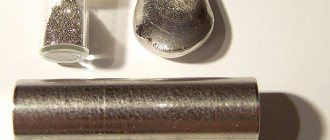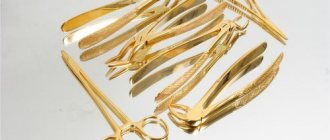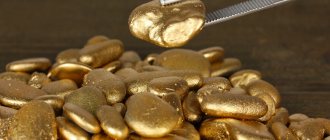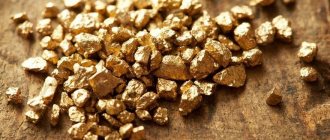GOLD, Au (lat. Aurum * a. gold; n. Gold; f. or; i. oro), is a chemical element of group I of the periodic system of Mendeleev; atomic number 79, atomic mass 196.967. Natural gold consists of the stable isotope 197Au. 13 radioactive isotopes with mass numbers 192-196, 198-206 and half-lives from a few seconds to 15.8 years were obtained. Gold items were discovered during excavations of the most ancient civilizations of the Neolithic era in the mountains of France, in Celtic burial grounds, in predynastic monuments of Egypt, among the most ancient cultural layers in India and China. The refining of gold and its separation from silver began in the 2nd half of the 2nd millennium BC. The first studies of gold are associated with the development of alchemy, the main goal of which was to create gold from base metals.
- Physical properties
- Chemical properties
- Being in nature
Physical properties of gold
Gold is a soft, bright yellow heavy metal. Crystal lattice of gold is cubic face-centered, parameter a = 0.40783 nm (4.0783 E), physical properties: density (at 20°C) 19320 kg/m3; melting temperature 1046.5°C; boiling point 2947°C, specific thermal conductivity (at 0°C) 311.48 W/(m•K), specific heat capacity (at 0°C and pressure 1 atm) 132.3 J/(kg•K); resistivity (at 0°C) 2.065•10-8 Ohm•cm, at 100°C 2.8873•10-8 Ohm•m; temperature coefficient of electrical resistance 0.0039°C-1 (0-100°C); electrical conductivity with respect to copper (at 0°C) 75.0%; coefficient of linear expansion (0-100 °C) 14.6•10-6 K-1; for annealed gold, the tensile strength is 100-140 MPa; Brinell hardness 18.9•10 MPa.
Gold has the highest ductility and malleability compared to all other metals. It is easily flattened into the thinnest leaves, so 1 g of gold can be flattened into a sheet with an area of 1 m2. Easy to polish. Reflectivity is high. Oxidation states of gold are +1, +2, +3, +5. In gold compounds, the most common valences are +1 and +3. Bivalent gold is stable only in the form of sulfide; other Au2+ compounds are decomposed by water.
Chemical properties of gold
Gold has exceptional chemical inertness; it is the only metal that is not affected by dilute and concentrated acids. Under normal conditions, gold does not interact with either oxygen or sulfur. Gold is resistant to atmospheric corrosion and various types of natural waters.
Gold usually dissolves in aqueous solutions containing a ligand (which forms complexes with gold) and an oxidizing agent, but each of these reagents, taken separately, is not capable of dissolving gold. For example, gold does not dissolve in hydrochloric or nitric acid, but easily dissolves in the so-called aqua regia (mixture 3:1 HCl + HNO3) with the formation of chlorauric acid NAuCl4, in chromic acid in the presence of chlorides and bromides of alkali metals, in cyanide solutions in the presence of air or hydrogen peroxide to form cyanoaurathione.
Gold also dissolves in solutions of thiosulfate, thiourea, in a mixture of Kl + I2; at elevated temperatures it interacts with tellurium to form AuTe2, and reacts with all halogens. Bromine is the most reactive towards gold: it enters into an exothermic reaction with gold powder at room temperature, giving Au2Br6. The reaction of gold with chlorine is extremely slow due to the formation of surface compounds. Only at temperatures above 200°C is a high reaction rate achieved, since at these temperatures the gold chlorides sublimate, resulting in a permanently exposed clean surface. The reaction product is AuCl3. When gold salts are reduced with tin dichloride, a stable colloidal solution of bright red color (“Cassius purple”) is formed.
Gold oxides (AuO2 and Au2O3) can only be obtained by evaporating the metal at high temperature in a vacuum. Red-brown hydroxide Au(OH)3 precipitates when a solution of AuCl3 is exposed to strong alkalis. Salts of Au(OH)3 with bases - aurates - are formed when it is dissolved in strong alkalis. Gold reacts with hydrogen, forming a hydride, at a pressure of 28 to 65•108 Pa and a temperature of more than 350°C. MeAuS sulfoaurates are formed by the reaction of gold with alkali metal hydrosulfides at high temperatures. Gold sulfides Au2S3 and Au2S are known, but the latter are metastable and decompose with the release of a metal phase. A characteristic feature of gold is its pronounced tendency to form complex compounds.
Complex compounds of gold with various ligands are known: chloride AuCl2-, AuCl4-; hydrooxo complexes Au(OH)-, Au(OH)2-, Au(OH)4-; mixed hydroxychloride type AuCl2(OH)2-; bromide AuBr2-, AuBr4-; iodide AuI2-; fluoride AuF4-, AuF6-; sulfide and hydrosulfide AuS-, Au(HS)-; thiosulfate Au(S2O3)2-; cyanide Au(CN)2-; complexes of gold with various organic compounds. All soluble gold compounds are toxic. The abundance of gold in the Universe is 5.34•10-8%. The relative content of gold in the Sun is 4.0•10-6%, which is an order of magnitude higher than in the rocks of the Earth.
Causes of darkening of gold
Several years ago, ex-millionaire Sterligov claimed that the Central Bank’s 999 gold coins rusted after being in the ground. However, rust on gold is a questionable matter. But products made of gold alloys can oxidize, that is, tarnish or darken, and there are several reasons for this:
- Compound. Jewelry is not made from pure gold. For strength, alloys of different volume and composition are introduced into the alloy, which changes the physicochemical properties of the metal. The lower the grade, the higher the likelihood of rapid wear. In this case, the jewelry darkens due to the fact that the metal oxidizes.
- Iodine. As a reagent, this harmless antiseptic destroys the molecular structure of the outer layer of products. As a result, gray spots appear on the jewelry. That is why it is recommended to remove gold jewelry when visiting swimming pools and SPA treatments. Once the top layer is damaged, the products begin to oxidize.
- Chemical industry products. Cosmetics, detergents, and some medications contain substances that can adversely affect the appearance of jewelry made from precious alloys.
Supporters of esoteric theories claim that noble metals “feel” their owner. Gold fades if a person’s aura changes or he is damaged.
In addition, sweat and fat particles remain on the outer layer, onto which dirt from the environment settles over time. If oxidizing jewelry is not cleaned in a timely manner, it will appear that the gold has turned black.
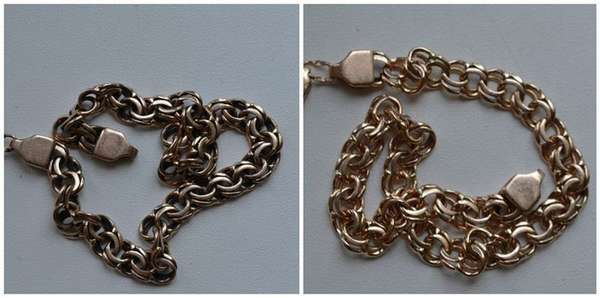
Finding gold in nature
Its average content in the earth's crust is 4.3•10-7 (according to A.P. Vinogradov). In increasing concentration, gold is arranged in the following series of natural formations: sea water, sedimentary rocks, acidic igneous rocks, intermediate igneous rocks, basic and ultramafic igneous rocks, chromites of basaltoid rocks, hydrothermal ores.
In the hydrosphere, the gold content is 1.0•10-9%, i.e. more than two orders of magnitude below the average for the earth's crust. However, the total amount in the hydrosphere is huge and amounts to about 5-6 million tons. The average gold content for all types of fresh water is about 3.0•10-9%. The gold content in sea water is variable: in the polar seas 5.0•10-9%, off the coast of Europe 1-3.0•10-7%, in the coastal zones of Australia up to 5.0•10-6%. The gold content in sedimentary rocks is relatively low (1.79-4.57•10-7%). At the same time, the formation of industrial concentrations (gold placers) is associated with sedimentary formations. In igneous rocks, the average gold content corresponds to the value of 3.57• 10-7%, while there is a tendency for the average gold content to increase from acidic to basic rocks.
The mobility of gold in geological processes is mainly associated with the influence of aqueous solutions. The most realistic occurrence of gold in hydrothermal solutions is in the form of various simple and mixed mononuclear Au+1 complexes. These include hydroxyl, hydroxochloride and hydrosulfide complexes. At elevated levels of antimony and arsenic, the formation of heteronuclear complexes of gold with these elements is possible. Transfer of gold in atomic form is possible. In low-temperature hydrothermal conditions, as well as in surface waters, migration of gold in the form of soluble organometallic complexes is possible, among which the most likely are fulvate and humate complexes. Under hypergene conditions, gold migration occurs in the form of colloidal solutions and mechanical suspension. Gold is characterized by a variety of factors leading to its concentration and fixation. Along with changes in temperature, pressure and pH, a change in the redox potential of the medium plays a major role in the concentration of gold. Co-precipitation and sorption play a significant role in gold concentration processes.
In nature, gold is mainly found in the form of native gold, as well as in the form of solid solutions with silver (electrum), copper (cuproauride), bismuth (bismutauride), rhodium (rhodite), iridium (iraauride) and platinum (platinum gold). The known gold tellurides are AuTe2 (calaverite) and AuTe3 (montbreuite). Natural gold sulfides have not been found, but in a number of places the gold and silver sulfide utenbogardite (Ag3AuS2) has been found. A number of gold-bearing tellurides and sulfides are also known. For the main genetic types of gold deposits, see the article Gold ores. The most ancient method of gold separation - gravity - is the leading process for obtaining gold-containing concentrate. Since the 1st millennium BC. When extracting gold from concentrates, amalgamation was used (dissolution with metallic mercury followed by distillation of mercury). At the end of the 18th century. and during most of the 19th century. The chlorination method became widespread. Chlorine was passed through the crushed ore concentrate, and the resulting gold chloride was washed out with water. In 1843, P.R. Bagration proposed a cyanide method for separating gold, which is widely used and makes it possible to almost completely isolate gold even from the poorest ores. To extract gold, the ore concentrate is treated in the presence of air with a dilute solution of NaCN. In this case, gold goes into solution, from which it is then released by the action of metallic zinc. Gold obtained in one way or another is purified from impurities by treating it with hot sulfuric acid. The economic importance of gold is determined by its role as the main currency metal. In technology it is used in the form of alloys with other metals. Gold plating is used in aviation and space technology, for the manufacture of some reflectors, electrical contacts and conductor parts, as well as in radio equipment. In electronics, contacts are made from gold doped with Ge, In, Ga, Si, Sn and others. A significant portion of the gold is used for jewelry. Gold is also used in medicine; radioactive gold (usually 198Au) helps diagnose tumors.
Tips for cleaning and selecting gold jewelry
When cleaning products made of precious metals, you need to pay attention not only to the composition, but also to the inlay, as well as the style of execution. For example, pearls, turquoise, and corals cannot be cleaned using ammonia. But diamonds from ammonia, on the contrary, will shine with renewed vigor.
Vsevolod Kozlovsky6 years in the jewelry business. Knows everything about samples and can identify a fake in 12 seconds. Airy weaves and too intricate patterns should not be wiped or polished yourself. Even with the use of alloys, gold remains quite soft and breaks quickly.
Do not use brushes on white gold or gold-plated items. Even the softest bristles can damage the coating and cause the item to begin to oxidize. But it is best to initially choose jewelry that suits your lifestyle.
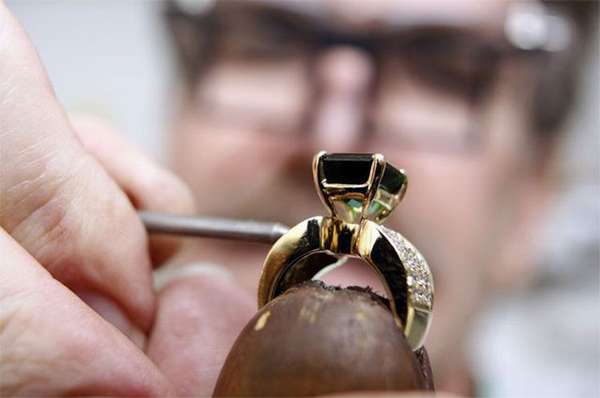
If you are used to leading an active lifestyle and do not like spending time on cleaning and polishing jewelry, then you should choose exclusively 750 gold. Let these be simple forms with simple inlay or even without it. Such products require virtually no maintenance, oxidize little and are easy to clean if necessary.
The 750 test is worth paying attention to for people with a slow metabolism and profuse sweating. The fewer impurities in the alloy, the longer the decoration will retain its attractive appearance.
Products imitated with gold that do not tarnish
Any non-precious alloys, jewelry or gold plating lose their attractiveness over time and oxidize under the influence of the environment. However, with proper care, such products can please the owner for many years.
In addition, it is worth paying attention to jewelry made of metals such as titanium. Under the influence of high temperature and various reagents, it oxidizes, acquiring all kinds of shades, including yellow. Products made from it look very elegant and last longer than sprayed jewelry.
Products made of brass and bronze look no less attractive. They are easy to use and look stylish in combination with your everyday wardrobe. The main rule for caring for such jewelry is timely cleaning of dirt.

